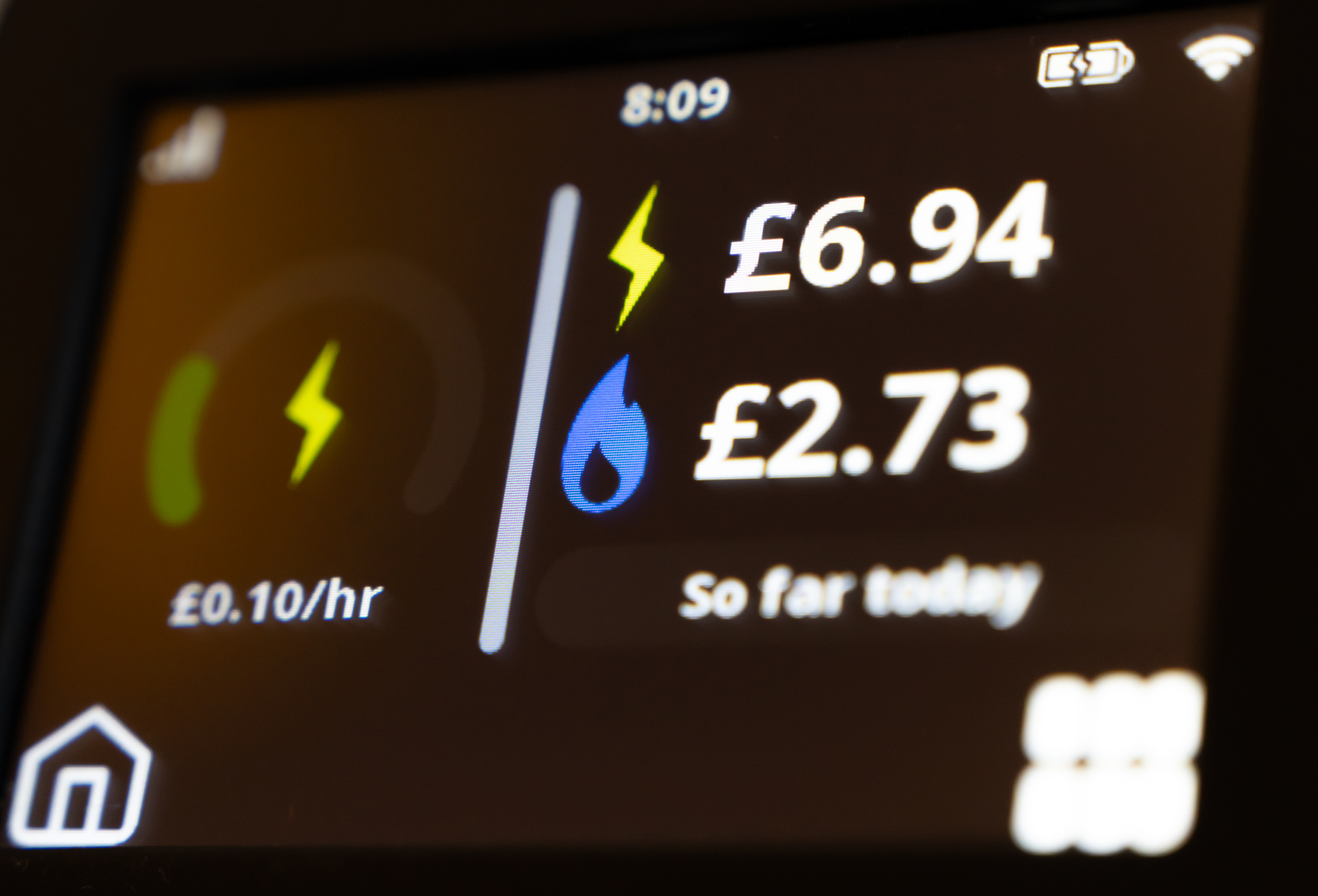Will gas and electricity bills fall? Energy price forecast
Billpayers in the UK have seen their energy bills rise by around £35 a year after the October price cap was introduced. Where will prices go next?


Energy bills rose by 2% on 1 October under the Ofgem price cap, seeing the average household's gas and electricity bill go up to around £1,755 a year.
Ofgem’s energy price cap, which changes every three months, has drastically fallen since 2022, when it would have peaked at £4,279 if not for the Energy Price Guarantee. But energy bills have still remained north of £1,500.
The aim of the price cap, set by the regulator Ofgem, is to ensure households aren’t overcharged for gas and electricity while reflecting higher wholesale costs being paid by suppliers.
MoneyWeek
Subscribe to MoneyWeek today and get your first six magazine issues absolutely FREE

Sign up to Money Morning
Don't miss the latest investment and personal finances news, market analysis, plus money-saving tips with our free twice-daily newsletter
Don't miss the latest investment and personal finances news, market analysis, plus money-saving tips with our free twice-daily newsletter
Any maintenance or upgrades needed to the energy network and government environmental schemes like the Sizewell C nuclear project are also factored in.
The price cap figure refers to the typical annual bill for a household on a dual-fuel tariff paying by direct debit, so you may pay more or less, depending on your energy consumption and how you pay.
The price cap for the period 1 January to 31 March 2026 has already been confirmed by Ofgem, with prices rising 0.2%.
But what is forecast to happen from then on? We look at what the experts and analysts are predicting.
Will energy bills fall next year?
Ofgem has confirmed the price cap will increase by 0.2% in the first quarter of the new year.
For the average household on a default dual-fuel tariff (which covers gas and electricity), paying by direct debit, this means their bills will rise from £1,755 a year now to £1,758 a year from 1 January, around 28p extra per month.
The January to March 2026 price cap can be found below:
Energy price cap per unit and standing charge 1 October to 31 December 2025 | Energy price cap per unit and standing charge 1 January to 31 March 2026 | |
|---|---|---|
Electricity | 26.35 pence per kWh 53.68 pence daily standing charge | 27.69 pence per kWh 54.75 pence daily standing charge |
Gas | 6.29 pence per kWh 34.03 pence daily standing charge | 5.93 pence per kWh 35.09 pence daily standing charge |
Source: Ofgem
The small rise comes with the cost of wholesale energy falling but new charges to be included within the cap from 1 January. The most significant of these is the new Regulated Asset Base (RAB).
The RAB is designed to raise money to support investment in new nuclear power stations by spreading the costs of construction and operation across consumer bills.
The main nuclear project this is currently funding is the Sizewell C project in Suffolk, which the government has committed £14 billion to. Ministers say, once built, the site will produce enough electricity to power roughly six million homes and protect households from volatility in the wholesale gas market.
Where will energy prices go next year?
While energy prices will increase fractionally in the first quarter of 2026, a bigger shake-up can be expected in April.
In the Autumn Budget, chancellor Rachel Reeves said average household energy bills will be cut by around £150 a year after she announced some green levies will be axed in April 2026.
The chancellor announced 75% of the costs of the Renewables Obligation, which places an obligation on suppliers to buy renewable energy, will be taken off household energy bills for three years.
She also announced the blighted Energy Company Obligation (ECO) scheme, which requires some suppliers to help low-income households increase their energy efficiency by installing energy-saving measures, will not be extended past March 2026.
A National Audit Office report published in October claimed poor quality installation of external wall insulation which could lead to mould and damp was carried out in 98% of homes under the scheme.
By removing the two green levies, the chancellor expects to shed around £150 from household energy bills. Energy consultancy Cornwall Insight estimates savings to be slightly less, at £145.
Forecasters were expecting a steep increase in the price cap in April 2026, possibly as much as £57 according to Cornwall Insight, so the £150 drop in bills will come as a positive to households.
Cornwall Insight, which is well-regarded for the accuracy of its price cap predictions, now forecasts the April price cap to be £1,675 per year for a typical dual fuel consumer, down £83 from the January cap.
Craig Lowrey, principal consultant at Cornwall Insight, said: “Lower bills are always welcome, but we need to be realistic about what these measures achieve. Shifting some levies around does not remove the costs of running and decarbonising our energy system, it simply changes how they’re paid for.”
Lowrey added that while the policy will “take the sting out of energy bills right now,” the cost of cutting bills will be picked up elsewhere.
“Moving them to general taxation may mean those paying more tax shoulder a bigger share, so you could say it spreads the burden. But for most households, it won’t make a huge difference to what’s in their pocket.”
What do other forecasters say?
EDF Energy has predicted the annual price cap will fall by £89 in April to £1,669.
The energy firm then expects prices to remain lower in the rest of 2026 thanks to the £150 cut. It expects bills to fall in the third quarter of 2026 before rising marginally in the last quarter of the new year.
Period | Price cap prediction (per year) | Confidence level |
|---|---|---|
Q4 2025 | £1,755 | Confirmed |
Q1 2026 | £1,758 | Confirmed |
Q2 2026 | £1,669 | Low |
Q3 2026 | £1,643 | Very Low |
Q4 2026 | £1,652 | Very Low |
Source: EDF, accurate as of 2 December
Take any predictions of future energy prices with a pinch of salt as it’s difficult to forecast where they will go, particularly as the wholesale energy market can be so volatile.
This is part of the reason why the government wants to create more energy inside the UK, so the network is less exposed to external factors.
What about in the longer term?
Energy bills are expected to rise over the next five years to fund a £28 billion investment in the energy network.
Energy firms were given the green light to upgrade power and gas grids in December 2025, but households will have to pay for it through their bills.
Ofgem said household electricity and gas bills will rise by a net of £30 per year by 2031. This factors in any savings that will be made by consumers due to the upgrades.
The regulator said it would hold firms to account for delivering any upgrades on time and on budget.
What do rising energy prices mean for you?
As the energy price cap rose on 1 October, households on a variable tariff will find they are paying slightly more for their energy than they did between July and September.
While Ofgem estimates the average annual bill for the last quarter of 2025 is £1,755, some households will pay more than this and some will pay less.
This is because unit costs and standing charges are capped, not energy bills. Households that use more gas and/or electricity could end up paying significantly more while ones that restrict their energy usage will pay less.
The below table summarises how unit costs and standing charges have changed over the course of this year. It also has the latest forecast from Cornwall Insight for April, which includes the expected savings from the chancellor’s green levy cut.
| Header Cell - Column 0 | July price cap | October price cap | January 2026 price cap | April 2026 (Cornwall Insight prediction) |
|---|---|---|---|---|
Electricity unit cost (per kWh) | 25.73p | 26.35p | 27.69p | 26.47p |
Electricity standing charge (daily) | 51.37p | 53.68p | 54.75p | 0.65p |
Gas unit cost (per kWh) | 6.33p | 6.29p | 5.93p | 6.17p |
Gas standing charge (daily) | 29.82p | 34.03p | 35.09p | 0.34p |
Typical annual household bill | £1,720 | £1,755 | £1,758 | £1,675 |
Source: Ofgem (confirmed figures) and Cornwall Insight (April forecast). Typical annual bill based on customers paying by direct debit. Latest Cornwall Insight predictions as of 30 November.
Should I fix my energy?
There are a number of fixed energy deals on the market currently charging up to 13% less than the current price cap, meaning there are some savings to be had.
However, with energy bills falling by £150 from April, these savings could be partially offset. But if you prefer certainty over what you’re paying, a fixed deal could be for you.
It’s worth noting, fixed energy tariffs don’t fix what you pay, just the rate for each unit of gas and electricity for a fixed amount of time, usually 12 months.
For more information on whether or not you should fix your energy bills, read our article on if you should switch to a fixed energy tariff.
How to keep energy bills low
To help you keep energy bills low, we have gathered some top tips in our article looking at 14 ways to reduce your energy costs.
If you're interested in the best ways to improve your energy efficiency and reduce costs, we explore radiators versus electric heaters, heated airers versus tumble dryers, and wood burning stoves versus central heating in separate articles.
How to get help with paying your energy bills
If you’re struggling to afford your energy bills, don’t bury your head in the sand and build up large debts.
Your energy supplier may offer support, for example, some suppliers have hardship grants. Octopus Energy has Octo Assist and British Gas has the British Gas Energy Trust.
You may be able to get a repayment holiday. This is where you ask your supplier to pause your repayments for a short amount of time to give you some breathing space.
Another option is to agree to an affordable payment plan. You will pay fixed amounts over a set period of time, which will cover what you owe plus an amount for your current use.
If you are on benefits, you might be able to repay your debt directly from your benefits through the Fuel Direct Scheme.
According to Citizens Advice, the Fuel Direct Scheme can be a good option if you can’t agree on a plan to pay back your debt, and it’s usually better than getting a prepayment meter.
Additionally, some government schemes give some households money towards paying their energy bills.
The Warm Home Discount is offered to households in receipt of some means-tested benefits who use participating energy suppliers and provides £150 of credit that is automatically paid towards your energy bill.
Meanwhile, if you are a pensioner with an income of £35,000 or less, you will be eligible for the Winter Fuel Payment, which provides retirees with up to £300 each winter.
What’s happening with standing charges?
The current standing charge regime is set to be shaken up by Ofgem after consumers criticised the current system as being unfair.
Under new plans from the energy regulator, households are set to be given the choice to pay lower standing charges, but at the cost of higher unit costs.
Every major energy firm will be required to offer their customers this choice by the end of January 2026 – but Ofgem has warned that energy bills are unlikely to fall. Instead, fees will simply be moved from one part of the bill to another.
Whether you should switch to the new tariff with lower standing charges in January 2026 depends on your own personal circumstances. Ofgem recommended households should ‘consider their circumstances and seek advice from their supplier or consumer groups’ to see if switching to a new tariff is best for them.
While some consumers may find this new option helpful, the results of the consultation have come as a blow to billpayers who want to see more significant reform to how energy bills are paid.
Other organisations, such as trade body Energy UK, have argued that this reform will simply serve to further complicate standing charges for consumers.
Get the latest financial news, insights and expert analysis from our award-winning MoneyWeek team, to help you understand what really matters when it comes to your finances.
Daniel is a financial journalist at MoneyWeek, writing about personal finance, economics, property, politics, and investing.
He is passionate about translating political news and economic data into simple English, and explaining what it means for your wallet.
Daniel joined MoneyWeek in January 2025. He previously worked at The Economist in their Audience team and read history at Emmanuel College, Cambridge, specialising in the history of political thought.
In his free time, he likes reading, walking around Hampstead Heath, and cooking overambitious meals.
- Ruth EmeryContributing editor
- Sam WalkerStaff Writer
-
 Household savings ratio drops – are you setting enough aside for 2026?
Household savings ratio drops – are you setting enough aside for 2026?High inflation has pushed the savings ratio down again and the figure could dip further next year
-
 US stocks: opt for resilience, growth and value
US stocks: opt for resilience, growth and valueOpinion Julian Wheeler, partner and US equity specialist, Shard Capital, highlights three US stocks where he would put his money
